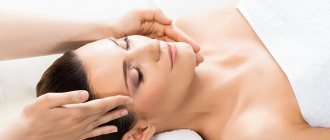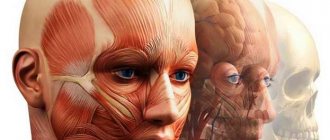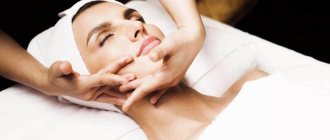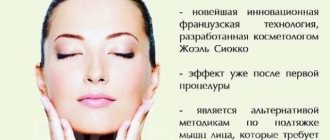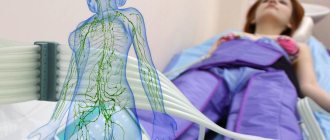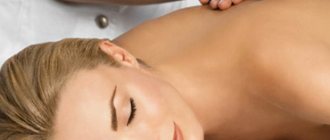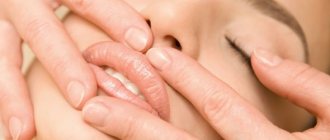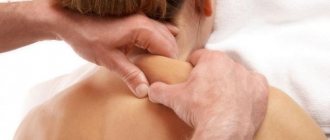Stress, overwork, physical and mental stress - constant companions of a person - often cause health problems. According to statistics, 80% of the world's population develop areas of excessive muscle tension in the body, which lead to a number of problems. Spasms are accompanied by severe pain, disruption of blood flow and metabolic processes in tissues, and limitation of motor functions. Fortunately, there is a good way to achieve complete relaxation of the fibers and eliminate painful symptoms.
This is myofascial massage - the latest therapeutic technique that came from America not long ago and has already become popular all over the world. Let's get to know her better.
Fascia and its functions
The word fascia is translated from Latin as “bandage”, “bandage” or “case”. In anatomy, fascia is a dense connective tissue that literally permeates the body, creating a sheath for muscles, enveloping internal organs, bones and nerve fibers. This is an important element of the structure of tendons, ligaments, and joints.
Considered an auxiliary tissue, fascia nevertheless performs important functions:
- Keeps internal structures, muscles, tendons, blood vessels and nerves in a clearly fixed position.
- Actively participate in metabolism.
- Separate organs from each other, limiting anatomical structures.
- Attach muscles to the bones of the skeleton.
- They control muscle volume and prevent their deformation due to their elasticity and stretchability.
- By contracting, they allow you to hold the body in an awkward position.
- They transmit energy impulses, moving muscles and bones.
- Accelerate the flow of blood and lymphatic fluid.
- They protect blood vessels and nerves passing through the thickness of muscle tissue.
Fascia has memory and is able to change its shape with constant repetition of the same movements.
It has been proven that the elasticity of fascial tissues largely depends on the emotional state of a person: internal clamps, stress and tension make these structures rigid, reduce their flexibility, which leads to poor posture and stiffness of movements.
Myofascial pain syndromes localized in the back
O. V. Vorobyova, Doctor of Medical Sciences, Professor of the State Budgetary Educational Institution of Higher Professional Education First Moscow State Medical University named after. I. M. Sechenova Ministry of Health of the Russian Federation, Moscow
At an outpatient clinic, patients with back pain make up from 30% to 50% of patients, depending on the doctor’s specialization. The etiology and mechanisms of formation of back pain are extremely variable.
There are at least four most significant factors leading to pain:
structural changes in cartilage tissue (pathology of intervertebral discs, degenerative arthritis);
chronic muscle dysfunction (tension, spasm);
damage to the nerve fiber primarily due to compression (disc herniation, osteophyte, spinal canal stenosis);
psychological factors contributing to the complex components of psychosocial dysfunction.
In most patients, pain is caused by a combination of several factors that are the source of primary pain and/or support the persistence of pain. Musculo-ligamentous disorders almost obligately accompany back pain, and sometimes are the root cause of pain. They often remain unrecognized, which is due to the low awareness of medical specialists. The pathology of the musculo-ligamentous apparatus of the back is most clearly reflected by myofascial pain syndrome (MPS), characterized by muscle dysfunction and the formation of local painful compactions in the affected muscles. Approximately a quarter of all unilateral back pain syndromes are caused exclusively by MFS. How to diagnose myofascial pain?
Diagnosis of myofascial pain is based on anamnestic characteristics of pain and clinical examination. It is important to determine the type, intensity, duration and location of pain, as well as the factors influencing the intensity of pain. What facts should be clarified in the anamnestic? Particular attention should be paid to the facts of possible muscle injury. For acute pain, it is important to determine what movement caused the pain and test the muscles involved in that movement. With the gradual development of pain, it is important to examine chronically overworked muscles that are subject to microtrauma.
What examination should the clinician perform? Clinical examination necessarily includes assessment of passive and active movements and muscle tone. MFS is characterized by an asymmetric restriction of the motor pattern. An integral part of the diagnosis of MFS is muscle palpation and identification of trigger points (TP). When examining the effector muscle, extremely sensitive “nodules” called trigger points are palpated within the spasmodic muscle cords. Most researchers recognize palpation as the main method for diagnosing MFS; with sufficient knowledge of this technique, it is possible to identify 85–90% of TT. TTs localized superficially or in the area of localized spasm are most easily detected. To more accurately identify the localization and activity of TP, it is advisable to first relax the spasmodic, painful muscles. For this purpose, the post-isometric relaxation technique or, in the absence of special skills, passive mechanical relaxation can be used.
Depending on the location and volume of the muscle, various palpation techniques can be used (direct pressure on the TT with fingers, superficial palpation, pinch palpation). For superficially located small muscles, gentle palpation is performed with the fingertips. Easily accessible muscles (eg, sternocleidomastoid, upper trapezius, hip adductor, and others) are grasped between the thumb and fingers and the muscle fibers are passed between the fingers (pinch palpation). Finally, deep palpation is used for deep-lying muscles (gluteal, piriformis and others). It is necessary to wait 2–5 seconds after finger pressure on the TT and evaluate the reproducibility of the referred pain. The effectiveness of the method increases when using topographic maps of the favorite location of TP in muscles. Associated dermatomal sensitization and trophic swelling can be assessed using skin plucking. Additional research methods (electromyography, algometry, thermography, ultrasound techniques) play a supporting role in the diagnosis of MFS, since they have low sensitivity and specificity. How to clinically evaluate a trigger point? On palpation, the trigger point is felt as a clearly limited area of sharp pain. The CT size on average varies between 2 and 10 mm. Usually it is detected along one cord as the most painful point. When palpating the active TT, pain is observed under the examiner’s finger and in the usual pain zone (zone of referred pain).
The intensity of the pain often reaches such an extent that the pain leads to a rejection reaction (jumping symptom). Active trigger points can also cause non-painful phenomena. The most common vegetative symptoms are: local vasospasm, local hyperhidrosis, pilomotor activity. Paresthesias may be equivalent to pain phenomena in the reflected zone. It is generally accepted to distinguish active and latent myofascial TP. In the active form, there is constant pain, decreased muscle elasticity, and the development of referred pain in response to direct pressure on the TT. The intensity of pain and the length of the pain zone depend mainly on the degree of excitability of the TT. Latent TT demonstrates the same clinical characteristics as active points, but is significantly less pronounced. In addition, in the latent form, the pain is induced rather than constant. The induced pain is usually localized to the area of the affected muscle and the referred area. Some researchers believe that latent TTs may be associated with the genesis of muscle spasm. Potentially, they can reorganize into an active state. In addition, TTs can be classified into primary and secondary. Primary are called TPs, which are formed as a result of acute or chronic overload of the muscle concerned and whose activity is not related to the activity of other muscles. Secondary or satellite TTs are the result of mechanical stress and/or neurogenic inflammation due to the activity of primary TTs. In the absence of supporting factors, TTs may spontaneously disappear if the muscle remains at rest for several days. On the contrary, negative factors, and most importantly, the persistence of the influence of the original pathogenic factor, contribute to the formation of secondary triggers and an increase in the area of pain. Thus, the main clinical markers of MFS, summarizing the clinical picture, are: local or regional pain, limiting range of motion; palpation determination of hypertonicity in the affected muscle with areas of increased sensitivity within the “tight” cord (trigger point); reproducibility of pain when trigger points are stimulated; reduction of pain when stretching the affected muscle.
What factors contribute to the formation of MFS in the back? The formation of the MFS is based on both the characteristics of the muscular system bearing the postural load and specific load factors. The actual anatomical features of the back muscles, namely the absence of long tendons with close interaction between the muscles, paraspinal ligaments and fascia, make these muscles especially vulnerable to the formation of MFS. In addition, the muscles of the back and neck are among the least trained, which limits their functional reserve. Loading factors vary somewhat at different levels of the spinal column.
1. Cervical level. Myofascial pain syndromes are the most common cause of pain in the neck, shoulder, and headaches. This is the reason why neck pain occurs in 30–85% of people. Chronic strain of the neck muscles is most often a consequence of: anti-physiological postures associated with work organization disorders (improper sitting at a school desk, when working with a computer monitor, etc.); neck position during sleep (pillow features); postural adaptation of the neck in the presence of primary pain in adjacent regions (shoulders, temporomandibular joint, etc.). Acute injury to the musculo-ligamentous system of the neck is most often associated with an acceleration/deceleration type injury (extensor mechanism of injury). Most whiplash injuries occur in transportation accidents, but they can occur in other situations, such as diving.
2. Lumbar level. Instability of the motion segment most often leads to overload of the trunk muscles. A decrease in the elasticity of the disc fibers and dehydration of its matrix is the cause of the most common functional disorder in the motion segment - hypermobility of the intervertebral disc. At an early stage, this is compensated by contraction of the trunk muscles. However, the functional reserve of the muscle is limited and depends on the training of the muscles. Muscle tissue can be injured during single or recurrent episodes of biomechanical overload. Modern working conditions expose the back muscles to additional overload associated with muscle imbalance. For example, with a sedentary lifestyle, the human body is subjected to static loads most of the time, at this time dynamic muscles are constantly inhibited and gradually become flabby, while at the same time postural muscles contract and gradually lose elasticity. Chronic muscle imbalance is characteristic of modern urbanization. Also, various postural disorders, such as scoliosis and other skeletal asymmetries, can contribute to muscle overstrain.
3. Pelvic level. MFS affecting the pelvic floor muscles occur almost exclusively in women [1]. This is primarily due to the anatomy of the female body and the structural changes that the female body experiences during reproductive life. During puberty after menarche, the girl's pelvis expands, the gluteal muscles increase in volume, and the hips rotate inward, leading to a lateral displacement of the patella. Constant internal rotation of the hips can negatively impact the pelvic diaphragm, which increases a woman's risk of developing pelvic floor spasms in the future. Pregnancy or weight gain increases this risk. Normally, the kneecap extends beyond the second toe, which helps maintain stable balance when standing. In many women, due to lateral deviation of the patella, the mobility of the joint decreases, which leads to a flattening of the arch of the foot. These structural changes in the lower extremities lead to disruption of the physiological maintenance of balance when standing and to excessive stress on the pelvic floor muscles. Ligaments in women are more extensible than in men, which is a necessary condition for maintaining joint stability and ensuring the process of physiological childbirth, but at the same time, this ability is a predisposing factor in the formation of fascial and ligament dysfunction in women. A fall on the buttocks can lead to limited mobility of the sacrum and the appearance of pelvic pain due to tension in the ligamentous apparatus of the pelvic floor muscles. In humans, the lower half of the body has more mass than the upper. Insufficiently developed muscles and muscle hypotonia can aggravate lumbar lordosis and increase the forward tilt of the pelvis. Increased lumbar lordosis is also observed during pregnancy. The reduction of estrogen during menopause is the main factor in the disruption of the physiological curves of the spine in old age. Changing the natural curves of the spine creates additional stress on the muscular frame, especially on the pelvic floor muscles. How to diagnose secondary muscle pain? Regardless of the primary source of pain and its pathogenetic characteristics, the muscles of the trunk are involved in the pathological process, becoming secondary sources of pain. Secondary pain occurs in the skeletal muscles outside the spinal motion segment due to a reflex increase in muscle tone. The physiological basis for muscle tension that follows any pain lies in the immobilization of the affected area of the body, the creation of a muscle corset. However, the muscle spasm itself leads to increased stimulation of the muscle's nociceptors. An increase in the flow of nociceptive impulses increases the activity of motor neurons in the anterior horns and contributes to increased muscle spasm. A reflex tonic muscle tension is formed. An additional factor in the development of painful muscle spasms is the antalgic posture. Transferring weight to one leg leads to curvature of the torso and asymmetrical position of the pelvis with the subsequent development of pain in the sacro-lumbar joints and the muscles that provide movement in these joints. The nature of secondary muscle pain is dull, aching, and pulling. Their intensity can vary widely. From a diagnostic point of view, it is important that pain is provoked by movements and is significantly intensified in positions in which the muscles surrounding the spinal column are stretched. Pain can also intensify when maintaining the same position for a long time (driving a car, sleeping in an uncomfortable position, long flight, etc.). There are no symptoms of loss.
With lumbar musculoskeletal pain, pseudo-Lasegue syndrome can be observed. If, when performing the Lasegue test, pain occurs only locally in the lower back, or hip, or under the knee, or in the lower leg, this is due to a stretch of spasmodic muscles (paravertebral or posterior thigh muscles) (“short” pain). On palpation, the paravertebral muscles are compacted, tense, and painful. Secondary muscle pain can become chronic and persist on its own even after the original cause has been eliminated. How to treat myofascial pain? Treatment of MFS requires multipronged approaches. Standard treatment includes: drug therapy with drugs such as nonsteroidal anti-inflammatory drugs (NSAIDs) and muscle relaxants; impact on TT, including physiotherapy; therapy aimed at restoring the normal functioning of muscle tissue: reducing muscle strain, strengthening the muscle frame, changing lifestyle. The main short-term task is to destroy trigger points, which leads to pain reduction. But the impact on TT should not be carried out in isolation. The long-term goal is to relax the muscles, restore the balance between postural and dynamic muscles, and neutralize predisposing factors, which reduces the risk of recurrence of pain. Warming the muscle can help it relax; for this, applications of “warming” ointments, gels, as well as hot wet wraps of the affected muscle, and wet warm compresses can be used. If you have certain skills, TT can be mechanically destroyed by injection of anesthetics (novocaine, lidocaine), which shortens the period of pain associated with the procedure. TT injections can provide excellent results. Less commonly used is “dry needling” without the use of an anesthetic. Specialized centers use muscle stretching exercises and gentle muscle relaxation techniques, such as post-isometric relaxation. In addition, traditional relaxation massage can be effective. The duration of therapy is significantly reduced with rapid and effective pain relief for the patient. Pain relief with NSAIDs is generally accepted for MFS - Nise, Diklak, Brufen SR, Movalis, etc. The prescription of NSAIDs is mandatory for any severity of pain - from mild (NSAID monotherapy) to severe (in combination with other drugs). Applications to painful areas of gels and ointments containing NSAIDs or their general dosage forms (tablets, suppositories, injection forms) can be used. The combination of NSAIDs and muscle relaxants in the treatment of MFS has become almost standard, making it possible to reduce treatment time. In addition, the simultaneous use of muscle relaxants and NSAIDs allows you to reduce the dose of the latter and, therefore, avoid the development of side effects of therapy. While taking muscle relaxants, post-isometric muscle relaxation, massage, and physical therapy are facilitated. It has been proven that the use of muscle relaxants makes it possible to rid the muscle not only of active, but also of latent TP, i.e., it improves the long-term prognosis, reducing the recurrence of MFS. Randomized controlled trials demonstrate the superiority of this class of drugs over placebo.
A study conducted by the Cochrane Physicians Society, which included over thirty controlled trials, also confirmed the usefulness of the use of benzodiazepine and antispastic muscle relaxants [2]. Domestic researchers prefer non-benzodiazepine central muscle relaxants. Usually tizanidine, tolperisone, and baclofen are used. These drugs have fewer side effects than benzodiazepines. Tizanidine (Sirdalud) is a prominent representative of central muscle relaxants. The drug is registered for the treatment of painful muscle spasm caused by musculoskeletal diseases and spasticity. The combination of tizanidine with NSAIDs demonstrates a more pronounced effect on pain reduction compared to NSAID monotherapy in patients with back pain [3, 4]. In addition to reducing pain, tizanidine reduces the need for NSAIDs and tranquilizers in patients, thereby reducing potential side effects from treatment. Placebo-controlled studies have shown the actual analgesic effect of tizanidine, as well as its effect on muscle tension and reduction of active trigger points [5]. Therapeutic tactics completely depend on the severity of the pain syndrome, its duration and the number of muscles affected by the MFS. In acute MFS, Sirdalud can be used in monotherapy. The recommended daily dose of Sirdalud is 6 mg per day in 2 or 3 divided doses. For severe MFS, combination treatment is used, combining pharmacological and non-pharmacological methods. Adding Sirdalud to a comprehensive treatment regimen allows you to reduce the duration of taking NSAIDs and avoid taking tranquilizers. Since the mild sedative effect of Sirdalud allows you to cope with mild anxiety without prescribing psychotropic therapy. Adjuvant treatments (antidepressants, anxiolytics, hypnotics): There are no high-quality randomized controlled trials on the use of these agents in patients with MFS. But numerous studies show the effectiveness of these drugs for treating chronic pain. It should be noted that chronic pain is often associated with depression, and effective treatment of depression can significantly reduce pain. The presence of comorbid syndromes requires mandatory targeted therapeutic efforts. A necessary component of treatment is the patient's physical activity. It is necessary to recommend that the patient return to normal daily activities. Physical therapy has a positive effect. Avoiding postural tension, daily physical therapy, mastering autogenic training with the ability to relax muscles is an effective defense against muscle pain. It is necessary to encourage the patient to make a positive change in life style (avoidance of anti-physiological poses, rational equipment of the workplace, stopping smoking, weight control, physical therapy, annual massage courses, mastering autogenic training with the ability to relax muscles).
Literature Vorobyova O.V. Painful spasm of the pelvic floor muscles as a cause of chronic pelvic pain in women // Farmateka. 2011, no. 5 (218): 51–55. Van Tulder MW, Touray T, Furlan AD, Solway S, Bouter LM Cochrane Back Review Group. Muscle relaxants for nonspecific low back pain: a systematic review within the framework of the cochrane collaboration // Spine. 2003, Sep 1; 28 (17): 1978–1992. Berry H., Hutchinson DR Tizanidine and ibuprofen in acute low-back pain: results of a double-blind multicentre study in general practice // J Int Med Res. 1988; 16:83–91. Pareek A., Chandurkar N., Chandanwale AS et al. Aceclofenac–tizanidine in the treatment of acute low back pain: a double-blind, double-dummy, randomized, multicentric, comparative study against aceclofenac alone // Eur Spine J. 2009; 18 (12): 1836–1842. Lepisto P. Muscle relaxants for nonspecific low back pain: a systematic review within the framework of the Cochrane Collaboration // J Int Med Res. 1981; 9 (6): 501–505.
The article was published in the journal The Attending Physician
Source: https://medblog.su/prochie-tematiki/miofastsialnye-bolevye-sindromy-lokalizovannye-v-oblasti-spiny.html © medical portal MedBlog.su
Link to publication: medblog.su
Consequences of dysfunction
For various reasons, the structure and functions of the fascia can be disrupted, causing a lot of problems for a person.
- Excessive physical activity often causes muscle spasms, causing the fascia to become damaged or hardened, creating tense, painful areas.
Relieving pain in the legs: calf massage - Active muscle contraction increases the load on the connective tissue structure: the fibers are deformed (shortened or stretched), changing the position of the internal organs, disrupting their normal functioning, limiting mobility.
- Prolonged muscle spasms often cause the development of inflammation and degenerative changes in the structure of fascial fibers. And these processes are almost always accompanied by increasing pain.
- Dehydration or damage to tissue cells often causes changes in the shape and internal structure of the fascia, disrupting their conductivity. As a result, metabolic processes are inhibited: tissues do not receive enough oxygen and nutrients, which leads to rapid aging of the body.
Fascial tissue is often called the “sixth sense organ.” After all, free nerve endings, receptors responsible for pain and movement “sensors” are located here. Any disruption of the functioning of the “peripheral brain” can lead to sad results: we will stop coordinating any movement of the body in space and feel pain, which, as is known, is a signal warning of problems with the body.
One way to relieve back pain is to massage your lower back.
Is it possible to massage a hernia?
A herniated disc develops when the annulus fibrosus disc that connects the vertebrae to each other becomes damaged. The nucleus it contains protrudes outward and penetrates the intervertebral canal, where many nerve fibers are located. It compresses the nerves, causing pain not only in the affected area, but also in the area for which they are responsible for innervation - the neck, arm, leg.
Massage is one of the manual therapy techniques that has proven itself as an effective remedy. The procedure is recommended for hernia of the cervical, thoracic, and lumbar spine. Whether it is possible to do massage for spinal hernias and how to do it depends on the patient. At the initial stage, when the fibers of the intervertebral disc are damaged, but it is still intact, massage is prescribed as part of the treatment. At this time it gives the best effect. One course stops the progression of the disease, relieves pain, and starts regenerative processes.
Massage is a combination of weak and strong movements in the form of rubbing, pressure, vibration. Under their influence, the distance between the vertebrae increases, negative pressure is created, under the influence of which the core returns to the disc.
Nutrients that reach hard-to-reach areas:
- improve the regeneration of the disc and cartilage tissue;
- strengthen the ligaments of the spine;
- makes the vertebrae stronger and more resilient.
With protrusion, when the disc cracks increase, but the core remains inside, the approach changes. Massage must be done carefully, otherwise it can provoke the progression of the hernia. The correct technique will stop degenerative processes in the disc.
With prolapse, the nucleus partially comes out, which is accompanied by severe pain. In this case, gentle stroking is recommended, intense exposure is prohibited. Hydrotherapy in the bath has a good effect. The same technique must be followed when extruding. At this stage, the nucleus protrudes greatly from the disc, affecting more nerve endings than with prolapse.
During sequestration, the procedure is prohibited. The hernia does not just bulge, but breaks away from the disc and migrates along the spinal column. This is a very dangerous condition that can cause paralysis. Any load on the spinal table is prohibited. The patient often needs surgery.
The procedure goes well with other methods of physiotherapy - cold, heat, hydrotherapy, electrical nerve stimulation. A good therapeutic effect is achieved by massage in combination with physical therapy exercises.
The principle of action and results of massage
It is known that fascial tissue is very sensitive and is capable of changing its structure in response to external influences. Therefore, special techniques of deep myofascial massage, during which not the muscles themselves are worked, but the connective tissue membrane surrounding them, will help restore lost functions and relieve a person from pain and discomfort. As a result of this procedure:
- Blood flow increases, improving tissue nutrition and preventing oxygen starvation.
- The movement of lymph is activated, which removes toxins, poisons, waste products, and decay products from the body.
- Spasms and tension that impede normal muscle movement are eliminated.
- Muscle fibers gain strength and elasticity and quickly restore their performance.
- Trigger points are developed and the reflex organs are affected.
- The compressed fascial fibers are straightened, returning the internal structures of the body to their normal position, significantly improving a person’s posture.
The result of massage and physical exercises: before and after - The sensitive conductivity of the fascial chains is normalized, as a result of which precise commands are sent from the brain to the internal organs, clearly regulating the functioning of the latter.
The technique of working with fascia allows you to increase the mobility of the spine and joints, corrects the figure, promoting weight loss, relieves inflammatory processes, improves the appearance and condition of the skin. Moreover, this massage directly affects the nervous system, balancing the processes of excitation and inhibition, improving sleep, and improving mood.
It is important to warn the patient that a temporary reaction to exposure may include local redness of the skin, muscle twitching, chills, nausea and increased urination. This is how the body rebuilds itself and reacts to changes caused by the massage therapist’s manipulations.
Description of the procedure for myofascial massage of the face, neck and head
It is important to sign up for a myofascial facial massage service in a salon with a professional so as not to harm your health.
Rolling - the epidermis is raised, while moving with the second hand until resistance appears.
All actions are directed along the muscle fibers.
Head
All manipulations are performed at a fast pace.
- The massage therapist works with both hands, performing intense circular movements in the hairline.
- With your head on the side, your thumb is placed in front of your ear, and the rest on the hair area. If the head is tilted to the right side, the work is done with the left hand, and vice versa. Warming up the skin occurs intensively, alternating with light stroking. Then the second side of the head is worked on.
- The hands are in the hair area, and the fingers are placed on the forehead. Actions are performed with three fingers. The middle and index fingers affect the forehead, and the large one works with the temporal part. The movements themselves change: confident and strong ones turn into soft ones, the skin moves and then moves apart.
Neck area
The neck is massaged simultaneously with the head. While the head is being worked, the specialist’s second hand is working on the neck. Impulsive, deep actions are performed with both hands.
Myofascial massage of the chin area is performed only after working with the frontotemporal area. Both hands apply circular rolling movements to the front of the neck and the area behind the ears.
Facial zone
More time is spent on the face. Here is an approximate sequence of actions:
- Using confident circular movements, the specialist works with two points under the edges of the mouth.
- Near the corners of the mouth, stroking and rolling are performed to the cheekbone area and back. Closer to the starting point, the movements intensify, complemented by pinching, creating a vibration effect.
- The eyelids, both lower and upper, are worked as follows: the skin is rolled from the outer corners.
- Moving from the bridge of the nose to the temples, fingers press on the areas, returning back - stroking and lightly pinching.
Read material on the topic: Face building for the face
Fascial massage of different zones
Long-term scientific research has proven that by acting on different areas of fascial tissue, it is possible to eliminate clamps, relieve spasm or muscle tension, relieve pain, even working at some distance from its source, restore or limit the mobility of various structures.
Indications and contraindications for head massage
Since fascial tissue literally permeates our entire body, different areas of it are subject to massage:
Back
The impact on this zone is exclusively health-improving in nature and is carried out in order to:
- develop painful trigger points;
- increase spine mobility;
- eliminate muscle spasms;
- release pinched nerve endings;
- improve blood circulation;
- relieve pain syndrome.
The patient is placed on his stomach to perform myofascial diagnosis. It allows you to determine the state of a person’s musculoskeletal system, the range of motion of the spine and joints, and identify existing and sometimes hidden diseases. Using examination and deep palpation, the massage therapist determines tension zones and trigger points, thus outlining an individual plan of action.
A session of myofascial massage begins with the cervical-collar area, then moves to the shoulders, goes down along the paravertebral lines and ends with working on the lower back and sacral part of the back. At the same time, classical techniques - stroking, rubbing, kneading - are combined with the myofascial technique of the “three Ts”: “tension” (pressure), “torsion” (twisting), “traction” (stretching). The treatment is carried out along the fibers, matching the deep impact with the patient’s breathing.
Legs
The legs and thighs are massaged to relieve tension, muscle pain, and increase endurance. The procedure is often used by athletes who experience physical strain on a daily basis.
Here, the stretching technique is most often used, which allows you to relax the fascia, restore their elasticity, and thoroughly work out the muscles. Massage slowly, in the direction of the fibers. With one hand they lightly fix the skin, with the other they move the fascia until a strong resistance is felt. Repeat the procedure until complete tissue relaxation occurs.
The so-called “felting” will help to stretch the compacted fibers of the fascia: the muscles are grabbed, lifted, pulled to the side, and then returned to their original position.
Face and neck
Myofascial work on the neck is primarily aimed at relieving pain that periodically occurs even in a completely healthy person. The method allows you to eliminate problems such as:
- spasms;
- pinched nerve roots;
- short neck syndrome;
- "widow's hump";
- subsidence of the vertebrae;
- ligament weakness;
- swelling;
- age-related degenerative changes.
Massage begins with diagnostics, determining the anatomical features of the muscle structure and tissue attachment points. Then they begin therapy aimed at removing the blocks. The fascia of the lateral surface of the neck is treated simultaneously with the impact on the scalp. Kneading and pressing are carried out with both hands at once.
Myofascial facial massage is used to remove puffiness, improve the color and condition of the skin, tighten the oval, and stop age-related changes. In addition, it helps in restoring facial symmetry after strokes and paresis.
Myofascial work-out involves a deep impact on the structures of the body, so you should get used to the procedure gradually, step by step increasing the duration - from 30 minutes to an hour and a half. To achieve lasting results, it is recommended to visit the massage room 2-3 times a week.
Indications for trigger point massage
Myofascial massage is effective against acute and chronic myofascial pain syndromes. Not only does it relieve muscle tension and pain, but it also helps athletes cope better with physical activity and prevent injury. However, the procedure is indicated not only for actively training people. It is useful for office workers who lead a sedentary lifestyle, as well as for patients who are overweight or underweight.
Treatment of the cervical-collar area is indicated in the following cases:
- pinched nerves or blood vessels;
- dizziness, headache;
- congestion or noise in the ears;
- decreased muscle tone;
- short neck syndrome;
- ligament weakness;
- osteochondrosis and its complications;
- "Widow's hump"
With the help of a massage of the neck and upper back, it is possible to get rid of vegetative manifestations caused by muscle tension and pain.
In addition to pain, indications for massage of the thoracic and lumbar regions may include scoliosis, osteochondrosis, numbness of certain areas of the body, and age-related degenerative changes.
Contraindications
Myofascial therapy can cause global changes in the body, so it needs to be taken seriously. You should avoid the procedure if you suffer from:
- oncology;
- tuberculosis;
- herpes;
- internal bleeding;
- dermatitis;
- pustular rashes;
- fragility of blood vessels;
- osteoporosis;
- blood diseases;
- rosacea.
Open injuries, wounds, burns, the presence of large moles, papillomas, nevi are also contraindications to deep tissue massage. Infectious and inflammatory diseases accompanied by high body temperature, pregnancy, recent childbirth or abortion, increased mental excitability - conditions in which exposure to the fascia can cause harm to a person.
Self-massage
Doctors unanimously say that this massage should only be performed by specialists. After all, without deep knowledge of anatomy and physiology, the ability to “read” and feel the human body with your hands, without practical skills in influencing fascial tissue, you can only harm the patient, aggravating his condition.
The only way out for those who want to do massage on their own is to use special devices. This could be a tennis ball, a spiked roller, or a roller for deep work on muscles and connective tissue.
- To begin with, you should feel your body with your hands, identifying painful or tight areas.
- Warm up the surface using classic rubbing.
- Using light pressure or rolling, work the problem area for 30–60 seconds.
- You need to act very carefully, trying not to cause pain.
You can learn more about self-massage methods from the video tutorial.
It is important to remember that this method is intended to work with muscles and fascia, so exposure to bones, joints and the spine is prohibited. Massage of the neck, where the arteries, nerve plexuses and vital organs are located, is also best left to a trained master.
How much does the procedure cost?
There is no standard script for the myofascial massage procedure. Its duration, intensity, and the range of techniques used depend on the characteristics of the body, age, diagnosis of the patient and are selected individually.
These factors also determine the price of the procedure. In salons in Moscow and St. Petersburg it varies from 500 to 4000 rubles per session. Thus, specialists will work on the fascia of the cervical spine for 500 rubles, and the entire back for 4,000 rubles.
Be prepared for the fact that an effective and lasting result will be obtained only after a full course of 7–10 procedures. If the price seems too high to you, wait for promotions or buy a certificate that provides a discount.
Number and cost of session
The duration of the course of manual massage is determined by the cosmetologist personally, taking into account the general condition of the skin, its needs, and the desired effect. On average, it is enough to attend 8 – 15 sessions to get a positive result. To consolidate the effect, it is advisable to repeat the course after 4 to 6 months.
The cost of a cosmetology service is determined taking into account the type of massage chosen, additional cosmetics used, the number of sessions, and the desired effect. In Moscow, prices start at 800 rubles and can reach 5,000 rubles.
Author's methods
Myofascial technique is relatively young, but it already has a lot of supporters. Some of them follow classical principles, others bring their own ideas, wanting to improve the technique and achieve better results. I would especially like to note the author’s methods:
- Enrique Garcia - his Spanish or chiromassage technique is aimed at removing clamps and blocks of muscle tissue by influencing the fascia. The result is facial rejuvenation, improved functioning of joints and blood vessels, correction of neurophysiological and metabolic processes occurring in the human body. You can read more about the benefits and rules for using the technique in the article: “Spanish facial massage.”
- Tatiana Shubina - the technique is aimed not only at facial rejuvenation and combating age-related changes (which undoubtedly attracts women), but also at significantly improving the patient’s well-being, combating migraines and dizziness. Cosmetologist and massage therapist Tatyana Shubina sees the reason for their appearance in muscle tension, which can be eliminated by massaging the fascia of the tendon helmet of the head, face, neck and ears.
Any of these techniques is not only therapeutic, but also an excellent preventive measure. Don’t wait for health problems to appear - start the procedures today and feel free to plan an active life full of strength and energy for decades to come.
Execution Rules
Since facial and décolleté massage is not only a cosmetic procedure, but also a therapeutic one, it is important to entrust it to a specialist with a medical education. For all types of massage, there are general rules of implementation that must be strictly observed:
- The technique includes 3 stages: preparation, direct manipulation, application of the care product.
- During the procedure, special cosmetic oils or creams can be used to ensure good gliding. During plastic massage, talc is used, which prevents stretching of soft tissues and ensures precision of movements.
- The procedure is carried out in a cosmetology room equipped with special equipment. The client sits comfortably in a chair, relaxes, and is in a positive mood.
- All movements of the master must be smooth and strictly in the direction of the massage lines. During the procedure, the patient should not experience any discomfort or pain.
- Before using any cosmetic oil or cream, an allergy test must be performed. To do this, the back of the hand is treated with a small amount of product, selected taking into account the type of skin and its needs. If within 10 - 15 minutes no irritation, redness or rash appears on the skin, then the product can be safely used.
- During the massage, intense manipulations alternate with relaxing ones. Each massage line has an end point, which is fixed with deep pressure. Only after fixation can you move on to the next section.
- Moving to the neck and décolleté area, the massage therapist should reduce the intensity of the impact, replacing them with delicate kneading and stroking. During the procedure, the patient should not experience discomfort or other unpleasant symptoms.
- Any massage technique ends with relaxing, stroking movements that relieve muscle tone. After the procedure, the patient feels peaceful, as if after a deep sleep or a long quality rest.
To consolidate the rejuvenating and healing effect of manual massage, after a course of procedures it is advisable to adhere to the following rules of a healthy lifestyle:
- Normalize your daily routine, try to get enough sleep and rest.
- Regularly use skin care products selected individually by a cosmetologist.
- Lead an active lifestyle, walk more in the fresh air, engage in moderate physical activity, give up bad habits.
- Eat regularly, in a balanced manner, giving preference to foods rich in nutrients, micro- and macroelements, and vitamins.
- Maintain a hydration regime, trying to consume at least 1.5 liters of clean drinking water during the day.
- Try to avoid stress factors, change your outlook on life, practice positive thinking.
